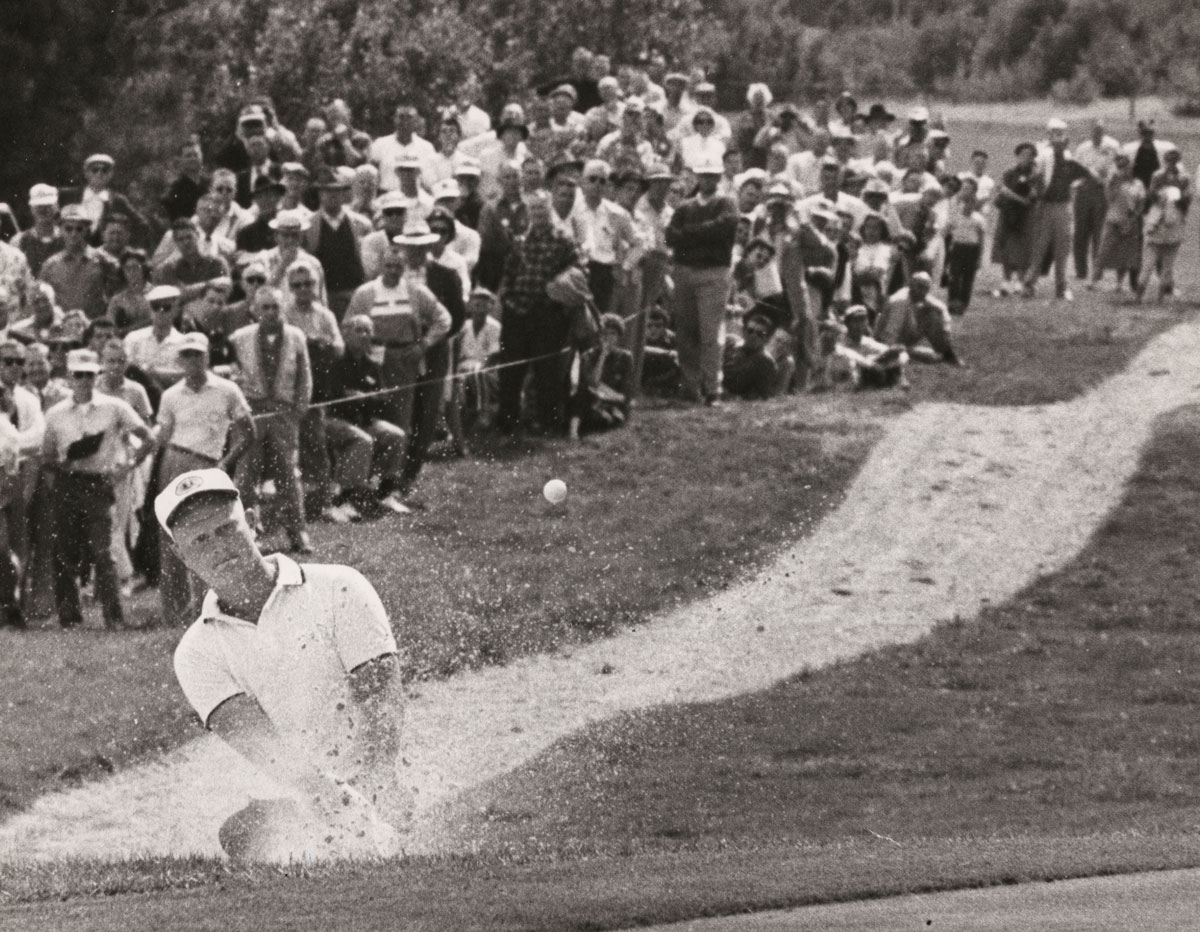A couple of stellar champions — along with consistently great storylines — have marked the U.S. Amateurs that have been played in Colorado; this year the state will host the event for the fifth time
By Gary Baines – 3/20/2023
The U.S. Amateur, the oldest USGA championship, has only been conducted in Colorado four times.
Of the four players who have won the event in the Centennial State, two are now in the top 10 in career PGA Tour victories: Jack Nicklaus (73, including 18 majors) and Phil Mickelson (45, with six majors).
On the other hand, the winner of the most recent U.S. Am held in Colorado, Steven Fox, has gone on to play in just 10 PGA Tour events, and has yet to make a cut.
The remaining U.S. Am champ in Colorado, Bob Dickson, fell somewhere in the middle, as he won twice on the PGA Tour — and once on PGA Tour Champions. But he has the distinction of being one of just four players in history — Bobby Jones being one of the others — to have won the U.S. Amateur and the British Amateur in the same calendar year.
When Cherry Hills Country Club hosts the 123rd U.S. Amateur Aug. 14-20 — with Colorado Golf Club in Parker serving as the second course for the stroke-play portion of the event — many local golf fans would love to see another player of similar stature to Nicklaus or Mickelson walk away with the Havemeyer Trophy. The odds may be against it — see above stat about the rarefied air the two occupy with their record in golf — but you never know.
Also keep in mind that in the 2012 U.S. Am that Cherry Hills hosted, guys such as Justin Thomas, Jordan Spieth, Max Homa, Bryson DeChambeau, Hideki Matsuyama and Xander Schauffele were in the field, but Fox walked away with the victory. (DeChambeau would go on to capture the U.S. Amateur title in 2015.)
With the fifth Colorado-based U.S. Am taking place this year — and with entries opening for the event this month — March 29, to be precise — it’s worth taking a look back on the previous times the championship has been held in the Centennial State. And, specifically when Nicklaus and Mickelson won, the victories were very notable from a historical perspective.
When Nicklaus prevailed in 1959 at The Broadmoor in Colorado Springs, it marked the first of his eight USGA championship titles. (It should be noted that the last of those eight also came in Colorado — at the 1993 U.S. Senior Open at Cherry Hills.) As for Mickelson, though he won 45 times on the PGA Tour and three NCAA individual titles, his only USGA victory to date came at the 1990 U.S. Am at Cherry Hills.
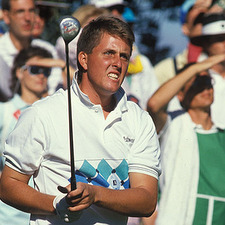
Here are some other highlights from the times the U.S. Am has been held in Colorado:
— 1959 at The Broadmoor’s East Course: The soon-to-be Golden Bear earned the first of his two U.S. Amateur victories, the other coming in 1961 at Pebble Beach. In the final at The Broadmoor, Nicklaus trailed Charlie Coe, the two-time U.S. Am champ (1949 and ’58), 2 down after 18 holes of the 36-hole title match. But Nicklaus prevailed on the 36th hole, 1-up.
After Coe pitched up for to the edge of the cup for a conceded par on the last hole, Nicklaus birdied from 8 feet to secure the victory.
At 19, Nicklaus became the youngest U.S. Am winner in 50 years.
“That’s probably the most important putt I ever made,” Nicklaus said in 2015 at the Century of Golf Gala at The Broadmoor. “In those days (the U.S. Amateur) was a major championship. What it did was it put me in a position where if I had to make a putt if I wanted to win something, I did. And winning breeds winning.
“The U.S. Amateur was the one that gave me the confidence to know that I could play, that I could do things under pressure. That was important to me.”
Even though Nicklaus’ first U.S. Amateur victory came more than a half-century ago, there are several moments that remain ingrained in his memory from that week in mid-September. One of them is a conversation Jack had one evening with his dad, Charlie. They were discussing Nicklaus’ round that day, and Charlie questioned whether Jack had made the correct choice in opting to chip a particular shot.
“Before my father even finished the question, I stopped him and said, ‘Whoops. Timeout.’ I told him, ‘Dad, you’re my best friend, I love having you with me and I always want you there. But I’ve got to do this myself; this is my deal.’ He looked at me and said, ‘You know, you’re right.’ From then on, he was my greatest supporter, my greatest fan and my best friend. But never again did he try to tell me how to play golf.”
— 1967 at The Broadmoor’s West Course: Two years after an improbable penalty in all likelihood cost him the U.S. Amateur title, Dickson won the national championship, defeating Martin “Vinny” Giles III by one stroke at The Broadmoor’s West Course.
In 1965, Dickson finished a stroke behind champion Bob Murphy after bogeying the last two holes. But during the second round, Dickson found he had 15 clubs in his bag and was penalized four strokes — two for each hole he played with the extra club.
As Sports Illustrated noted, “Dickson had never seen the extra wedge before, but someone in the caddie shop had carelessly shoved it into his bag.”
But Dickson’s victory in 1967 at The Broadmoor gave him a measure of redemption. Playing at the same resort where he won the 1966 Broadmoor Invitation, he also won the British Amateur that year, joining Hal Hilton (1911), Jones (1930) and Lawson Little (1934 and ’35) as the players to have captured both titles in the same calendar year.
As it turned out, Dickson was fortunate to even be able to compete in the 1967 U.S. Am. He had joined the National Guard in 1967, and needed to be given leave at the last minute to play in U.S. Am.
A year after winning the U.S. Amateur, Dickson was given the USGA’s highest honor, the Bob Jones Award, which goes to someone “who demonstrates the spirit, personal character and respect for the game exhibited by Jones, winner of nine USGA championships.”
Dickson went on to play 233 events on the PGA Tour and 256 on PGA Tour Champions.
Giles, the runner-up in 1967, finished second in three straight U.S. Amateurs, starting at The Broadmoor. But he went on to win the 1972 U.S. Am, plus a British Amateur and a U.S. Senior Amateur.
Though the U.S. Am had at least a match-play component for the great majority of its history, the exception was 1965-72, when it was an all-stroke-play affair.
— 1990 at Cherry Hills Country Club: In a championship full of interesting notes — look who won it, after all — Mickelson defeated a former high school teammate at University of San Diego High School, Manny Zerman, 5 and 4, in the scheduled 36-hole final. Mickelson and Zerman were both 1988 graduates of the school.
In the final, Mickelson made 10 birdies and played 32 holes in 4 under par in defeating Zerman. Mickelson had won the biggest tournament of his life to that point.
“This is the one that matters most,” he said earlier in the week. “I could finish last in every other tournament and win this one and be happy. This is the ultimate amateur tournament.”
Here were some of the highlights and notable tidbits from that week:
* A severe hail storm six weeks before the championship made it a challenge to get Cherry Hills ready for the tournament. The golf-ball-size hail left an estimated 750,000 to 1 million scars on Cherry Hills’ greens, some as large as 3 1/2 inches, and the course was closed for five days. A concerted effort by members and staff had the greens in good shape by the time the Amateur started on Aug. 21.
* While Mickelson has long come across as an extremely confident player, he was borderline cocky as a 20-year-old competing at the U.S. Amateur. To be sure, he was a standout, having won NCAA individual titles as both a freshman and sophomore at Arizona State. He was also low amateur in the 1990 U.S. Open. Mickelson finished third in the Colorado Open in 1989 and 10th in 1990.
Two-time U.S. Amateur champion Jay Sigel went so far as to call Mickelson “the best (amateur) I’ve seen.”
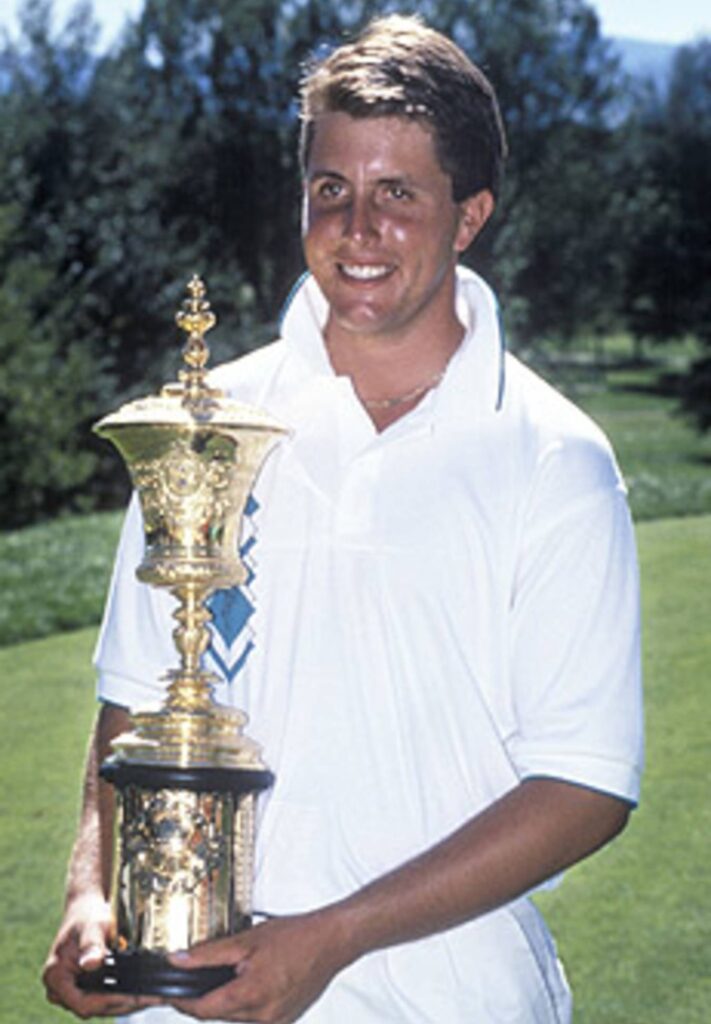
But, at the time, modesty wasn’t the strong suit of Mickelson, who consistently sported a preppy look back then.
After being medalist in the stroke-play portion of the Amateur, Mickelson said, “If I play the way I’ve been playing, I don’t think I’ll get beat.”
Also: “I’m playing as good as I’ve ever played. Every facet of my game is 100 percent right now. Whoever I play, I’d be intimidated (if I were them). So why shouldn’t they be?”
* In an example of his self-confidence, in his round-of-32 match, Mickelson had a 2-foot putt for birdie on No. 1, while his opponent, Jeff Thomas, had a 25-footer for par. Mickelson conceded Thomas’ putt.
“He didn’t give me a putt all day,” Mickelson later said of Thomas, who would go on to win the 1993 U.S. Mid-Amateur. “I just didn’t want him to go and (take the time) to line up the putt.”
As he later told USGA.org in recalling the event, “I’ll never forget the look that he gave me (after Mickelson conceded the long putt). It was just funny.”
* In stroke play, Mickelson broke the course record at Meridian Golf Club — and the existing U.S. Amateur record — by carding an 8-under-par 64, despite missing two 5-foot putts in the process. That gave him a 135 total for two rounds, good for medalist honors by two strokes. He gained that honor despite making a quadruple-bogey 7 on the 15th hole at Cherry Hills, where he four-putted.
* Ten Coloradans competed in the 1990 U.S. Amateur: current PGA Tour Champions player Shane Bertsch, Brett Dean, now-Colorado Golf Hall of Famer Rick DeWitt, Shawn McGechie, Tom McGraw, Guy Mertz, Robert Odom, Scott Petersen, Bill Werley and Charlie Whalen. None made match play, though DeWitt was in a playoff for the final match-play spots. Also failing to advance in that playoff was David Duval, who now lives in Colorado and is a member at Cherry Hills.
* On the first day of stroke play, Meridian yielded three holes-in-one.
* One player definitely stood out among the 312 competitors, though not necessarily for his golf. David Nissenbaum, a former state high school champion in Massachusetts, competed at Cherry Hills and Meridian with hair down to his shoulder blades and a foot-long beard. Nissenbaum also played in the 1967 U.S. Amateur — at The Broadmoor — but in the interim he served three years in federal prison for his role in allegedly smuggling 21 tons of marijuana. And, for good measure, he was a priest of the Ethiopian Zion Coptic Church, which uses marijuana in a sacramental role.
* Defending champ Chris Patton, all 310 pounds of him, lost 8 and 6 in the first round of match play when opponent Chris Zambri made hole-in-one with a 5-iron at the 204-yard 12th hole. After the ace, despite having already been eliminated, Patton couldn’t resist intentionally hitting his tee shot into the water. He turned pro immediately after the match.
* In three of his first four matches, Mickelson was taken the distance — to the 18th hole — including in the quarterfinals by Bob May, who went on to lose a playoff to Tiger Woods at the 2000 PGA Championship. Mickelson’s most remarkable comeback came in the round of 16. He was 1 down on the 16th hole, and for his second shot he had a huge cottonwood a few feet in front of him and directly between his ball and the hole.
Mickelson aimed at a creek 40 yards left of flagstick, hit a huge hook and put his ball 12 feet from the hole. He made his birdie putt and opponent Mike Swingle missed his 15 footer, evening the match.
“I had to snipe it 60 yards; I can’t believe I pulled it off,” Mickelson said. “… It was by far one of the better shot under pressure I’ve hit. If I don’t make it, it’s in the creek, then it’s over.”
Mickelson went on to win the 17th hole with a birdie and won the match 1 up despite being 4 over par for the round.
“About an hour ago, I had lost, I was done, heading home,” he said shortly after prevailing.
* Mickelson became the first left-hander to win the U.S. Amateur. And the victory made him the first player since Nicklaus in 1961 to win NCAA individual title and U.S. Amateur in the same year.
Capturing the U.S. Amateur title earned Mickelson a 1991 Masters pairing with Nick Faldo, who would finish his career with six major championships.
Noting at the time that he had never met Faldo, Mickelson deadpanned, “Good player, I hear.”
* Mickelson wasn’t a big fan of playing it safe when a challenge presented itself, so it’s not surprising that he regularly tried to drive the green on the par-4 first hole at Cherry Hills, as Arnold Palmer did successfully in the final round of the 1960 U.S. Open en route to rallying to victory.
But the strategy didn’t work out so well for Mickelson, who was 1 over par in seven times playing the hole during match play.
However, as Mickelson noted regarding another decision he made earlier in the week, “I’m just not one to lay it up — flat out.”
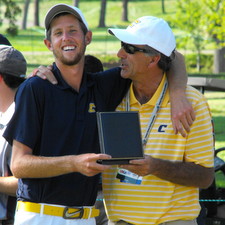
— 2012 at Cherry Hills Country Club: Despite the 2012 U.S. Am field being filled with some of the biggest-name golfers in the last 10 years (Thomas, Spieth, DeChambeau, Homa, Matsuyama and Schauffele), a little-known player walked away with the title.
Fox, a 21-year-old from Hendersonville, Tenn., and the University of Tennessee-Chattanooga, became the Fabulous Mr. Fox by coming back time after time to prevail at Cherry Hills. He thus earned the distinction of being the highest seed (63rd) to win the U.S. Amateur.
In the final, Fox was 8 over par through 27 holes, and even though he heated up after that, he was still 2 down with two holes left to play against University of California golfer Michael Weaver.
But Fox sank a 12-foot birdie putt to win the 35th hole, then watched as Weaver missed a 4 1/2-foot uphill par putt on 18 that would have won the title, but the ball horseshoed out, leaving Weaver in disbelief.
On the extra hole, Weaver pulled his drive near the second tee, and while keeping his ball under tree limbs, he left his pitch short of the green. His chip then came up 18 feet short of the cup.
Fox hit a 6-iron off the tee and wedged to 20 feet past the flag. With Weaver already lying three, Fox trickled his downhill putt into the cup for a birdie and the victory, setting off a frenzy of celebration.
“The whole match is the definition of being ‘Foxed,’” the term’s namesake said. “Definitely 2 down with two to go, then winning the first playoff hole by making a 20-footer there, that’s the definition of being ‘Foxed.’”
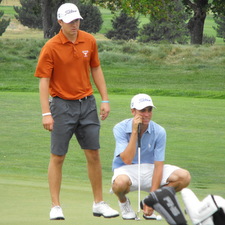
Maybe the whole 312-man field for the 112th U.S. Amateur was “Foxed”. Even going back to the 36-hole U.S. Amateur qualifying, Fox shot 73-64 to finish one shot ahead of a competitor who failed to make the national field.
Then at the Amateur itself, Fox needed a four-hole playoff to earn the second-to-the-last spot in match play. Then as the 63rd seed, he knocked off the No. 1-ranked amateur in the world (Chris Williams) and five other opponents to reach the promised land. And in the final, he was 3 down after 22 holes and 2 down after 34.
Other highlights from the 2012 U.S. Am:
* It marked the first time the U.S. Amateur final had gone extra holes since 2003.
* The night before they squared off for the U.S. Amateur title, Fox and Weaver attended the Denver Broncos-Seattle Seahawks game together at what was then known as Sports Authority Field in Denver.
“We went to the Denver Broncos game last night and had a great time,” Fox reported.
Then-Broncos executive vice president of football operations John Elway, a member at Cherry Hills, was on hand several times during the U.S. Amateur, and he spoke at the players’ dinner on the eve of the championship.
* USGA officials were very pleased with the attendance at the U.S. Amateur, saying the crowds were among the largest of any of the recent Amateurs. On the final day, the association reported that about 4,500 people watched the title match. That was roughly the same number that was on hand for the semifinals.
Beyond that, the entire week was nearly ideal from the USGA’s perspective.
“It was wonderful,” then-USGA executive director Mike Davis said. “Every time we come to Cherry Hills, something magical just happens. Whether it’s the 1960 U.S. Open — which is one of the great U.S. Opens we’ve ever had … And this is where (Phil) Mickelson kind of made his name (at the 1990 U.S. Amateur). And you think about Jack Nicklaus winning here at the (1993) U.S. Senior Open. And we had a great Women’s Open (in 2005).
* As far as the biggest names in the field went, Thomas fell to Weaver in the semifinals 3 and 2, Homa lost to Thomas 3 and 1 in the round of 32, Spieth was ousted 1 up by 2012 NCAA champion Thomas Pieters in the round of 64, and DeChambeau also lost in his first match, in 19 holes to Andrew Presley. Matsuyama (145 for 36 holes) and Schauffele (149) didn’t advance out of stroke play.
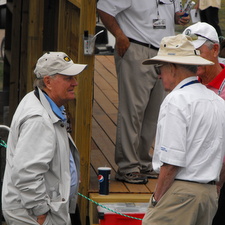
* Nicklaus was on hand during the early part of the week, watching his son, Gary, a former PGA Tour player who was in the field. Jack Nicklaus finished second in the 1960 U.S. Open at Cherry Hills, and won the 1993 U.S. Senior Open there.
“I haven’t seen Cherry Hills since I was there in ’93,” he said on the eve of the championship. “I’m looking forward to it. Anyplace I win I like. I’d be pretty stupid if I didn’t, right? I’ve always liked Cherry Hills. I’ve always enjoyed the golf course. It’s a golf course of discipline. Arnold (Palmer) took a run at the first hole, but most players better have a little discipline. I had an opportunity in 1960 to play the last 36 holes with (Ben) Hogan, and you want to talk about discipline. It was just absolutely magnificent. That was a great lesson for a young guy to watch Hogan play those two rounds.”
* CommonGround Golf Course, at that point just 39 months old, served as the second course for the stroke-play portion of the U.S. Am.
Besides the U.S. Am being conducted in Colorado four times previously, a few players with strong Colorado ties have won the event. That includes Coe (twice, in 1949 and ’58), who was a member at Castle Pines Golf Club late in his life; Craig Stadler (1973), who lived in Colorado for a quarter-century before recently moving to Florida; and Justin Leonard (1992), who resided in Aspen from 2015 until departing for Florida last year.
About the Author: Gary Baines owns and operates ColoradoGolfJournal.com










